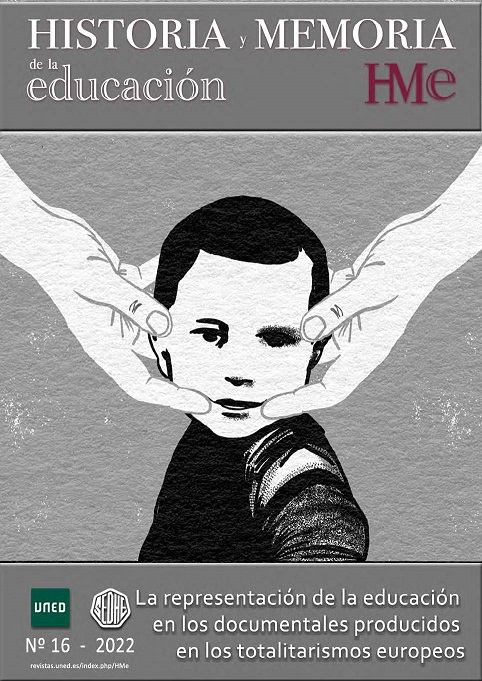Der Marsch zum Führer: los documentales y noticiarios en el adoctrinamiento de la juventud en la Alemania nazi
DOI:
https://doi.org/10.5944/hme.16.2022.31842Palabras clave:
Propaganda nazi, Educación, Adoctrinamiento, Juventudes Hitlerianas, Noticiarios cinematográficos, Cine documentalResumen
Los documentales educativos y noticiarios no han tenido una tradición como ámbito de investigación en España, salvo en los últimos años. Desde esta perspectiva, el presente artículo pretende contribuir al análisis de los documentales, así como de los mecanismos utilizados por el régimen nazi, para la promoción de determinadas propuestas educativas, tanto formales como no formales, con un claro objetivo adoctrinador en la juventud. Además de poner de relieve la instrumentalización propagandística de la cinematografía como parte fundamental de la educación en el interior del país y más allá de sus fronteras, analizamos el protagonismo de las Hitlerjugend y de la Bund Deutscher Mädel en el engranaje adoctrinador. Para fundamentar este discurso, hemos realizado un estudio a través de fuentes primarias, tanto fílmicas como textuales. Por un lado, el documental Der Marsch zum Führer, así como los noticiarios Junges Europa y NO-DO. Paralelamente, la red de instrumentos que controlaban la formación de la juventud, utilizó libros y revistas con discursos comunes a los materiales visuales trabajados, en obras como Marschtritt Deustschland y la revista Junges Europa. Los resultados ofrecen una serie de características educativas, tanto a través de símbolos visuales como de contenido escrito, que coinciden con los elementos propios de los totalitarismos europeos.
Descargas
Citas
Adam, Peter. El arte del Tercer Reich. Barcelona: Tusquets, 1992.
Almeida Aguiar, Antonio S. «Adoctrinar con la palabra: prensa y propaganda nacionalsocialista en las islas Canarias durante la Guerra Civil». Historia y comunicación social 25, no.2 (2020): 385. http://dx.doi.org/10.5209/hics.72270
Busto Miramontes, Beatriz. «El poder en el folklore: los cuerpos en NO-DO (1943-1948)». Trans. Revista Transcultural de Música 16 (2012): 1-30. Recuperado de https://www.sibetrans.com/trans/articulo/407/
Chomsky, Noam. La (des) educación. Barcelona: Crítica, 2010.
Collelldemont, Eulàlia y Conrad Vilanou (coords.). Totalitarismos europeos, propaganda y educación. Una historia visual desde los NO-DO. Gijón: Trea, 2020.
Collelldemont, Eulàlia. «Los campamentos juveniles y la naturaleza: un simple decorado» en Totalitarismos europeos, propaganda y educación. Una historia visual desde los NO-DO, coordinado por Eulàlia Collelldemont y Conrad Vilanou, 131-148. Gijón: Trea, 2020.
Collelldemont, Eulàlia (coord.). Registro de los reportajes y noticias en los que aparece representada la educación (1940-1975). Proyecto Análisis de las representaciones audiovisuales de la educación en documentales y noticiarios durante el franquismo (2013-2016). Recuperado de http://repositori.uvic.cat/bitstream/handle/10854/5845/
Cosandey, Roland. «Films nazis, 1933-1945». Cinémathèque suisse. https://www.cinematheque.ch/fileadmin/user_upload/Expo/films_nazis/films_%20nazis_%201.pdf
Davidson, Martin. El nazi perfecto. Barcelona: Anagrama, 2012.
De Ras, Marion E.P. Body, feminity and nationalism: girls in the German youth movement 1900-1934. NY, London: Routledge, 2008.
Dussel, Inés. «La verdad en la imagen propagandística. Reflexiones sobre un corpus enigmático (Westerbork, 1944)». Historia y Memoria de la Educación 8 (2018): 23-58. https://doi.org/10.5944/hme.8.2018
Fass, Paula S. (ed.). The Routledge History of Childhood in the Western World. London, NY: Taylor & Francis Group, 2012.
Grunberger, Richard. Historia Social del Tercer Reich. Barcelona: Ariel, 2007.
Gubern, Román. La imagen pornográfica y otras perversiones ópticas. Madrid: Akal, 1984.
Kaes, Anton. Shell Shock Cinema: Weimar Culture and the Wounds of War. Princenton: Princenton University Press, 2009.
Kracauer, Siegfried. De Caligari a Hitler. Una historia psicológica del cine alemán. Barcelona: Paidós, 1995.
Lepage, Jean-Denis G.G. Hitler Youth, 1922-1945: an illustrated History. London: McFarland & Company, Inc., Publishers, 2008.
Martín de la Guardia, Ricardo. «Propaganda y control social en la Alemania nacional socialista». Historia Social 34 (1999): 101-116. Recuperado de: https://dialnet.unirioja.es/servlet/articulo?codigo=121336
Mir Curcó, Conxita. Jóvenes y dictaduras de entreguerras. Propaganda, doctrina y encuadramiento: Italia, Alemania, Japón, Portugal y España. Lleida: Milenio, 2007.
Molina Poveda, María Dolores. «El NO-DO como medio de construcción de la identidad femenina (1943-1975)». Historia y Memoria de la Educación 12 (2020): 239-270. https://doi.org/10.5944/hme.12.2020
Moreno Cantano, Antonio y Misael López Zapico, «Propaganda del odio: las exposiciones anticomunistas en el Tercer Reich». Historia y Comunicación Social 19 (2014): 171-192. https://doi.org/10.5209/rev_HICS.2014.v19.47291
Mosse, George L. La nacionalización de las masas. Madrid: Marcial Pons, 2005.
Nicolás Meseguer, Manuel. La intervención velada. El apoyo cinematográfico alemán al bando franquista (1936-1939). Murcia: Universidad de Murcia, 2004.
Paz Rebollo, María Antonia y Carlota Coronado Ruiz. «Mujer y formación profesional durante el franquismo. NO-DO, 1943-1975», Pandora: revue d'etudes hispaniques 5 (2005): 133-145. Recuperado de https://dialnet.unirioja.es/servlet/articulo?codigo=2564574
Pine, Lisa. Education in Nazi Germany. Oxford: Berg, 2010.
Pinzón Olarte, Ivonne. «La construcción cinematográfica del enemigo en la Alemania nazi». Revista de Psicología Universidad de Antioquia 9, no. 2 (2017): 139-156. https://doi.org/10.17533/udea.rp.v9n2a09
Sander, Anneliese Ursula. Jugend un Film. Berlín: Zentralverlag der NSDAP, 1944.
Sandoval, Teresa. Historia del cine documental alemán (1896-1945). Madrid: T&B Editores, 2005.
Schumann, Dirk, «Childhood and youth in Nazi Germany» en The Routledge History of Childhood in the Western World, editado por Paula S. Fass, 451-468. London, NY: Taylor & Francis Group, 2012.
Stargardt, Nicholas. Witnesses of war: children's lives under the Nazis. London: Jonathan Cape, 2005.
Tornafoch Yuste, Xavier. «Las instituciones sociales modélicas», en Totalitarismos europeos, propaganda y educación. Una historia visual desde los NO-DO, coordinado por Eulàlia Collelldemont y Conrad Vilanou, 149-164. Gijón: Trea, 2020.
Welch, David (ed.). Propaganda and the German Cinema 1933-1945. New York: B Tauris, 2001.
Welch, David. Nazi propaganda. The power and limitations. New Yersey: Barnes & Noble Books, 2016.
Zeman, Zbynek A.B. Nazi Propaganda. Oxford: Oxford University Press, 1964.
Zimmermnann, Peter y Kay Hoffmann (eds.), Geschichet des dokumentarischen films in Deutschland. Band 3: Drittes Reich 1933-1945 (Stuttgart: Reclam, 2005). https://doi.org/10.25969/mediarep/14037
Descargas
Publicado
Cómo citar
Número
Sección
Licencia
Derechos de autor 2022 Historia y Memoria de la Educación

Esta obra está bajo una licencia internacional Creative Commons Atribución-NoComercial 4.0.

Reconocimiento – NoComercial (by-nc 4.0): Se permite la generación de obras derivadas siempre que no se haga un uso comercial. Tampoco se puede utilizar la obra original con finalidades comerciales.










